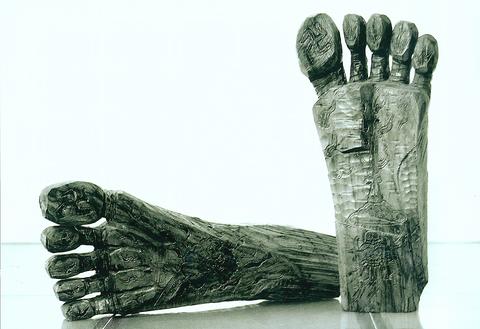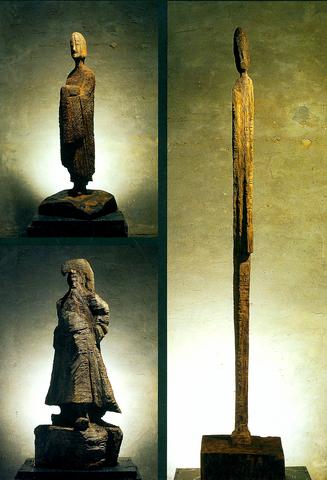Hsiao Yi (蕭一) has been making images of the Buddha since he was young. He started off as an apprentice to craftsmen at Buddhist and Taoist temples around southern Taiwan and later began to create his own wood carvings of the deities that decorate temples. His works can still be seen today at Pingtung's Matsu temple, among others. But despite achieving a level of technical brilliance, Hsiao used to see carving images of the Buddha as a job, in which good work came from training and practice. The Buddha was a subject of carving like any other.
This all changed when Hsiao gained a spiritual interest in Buddhism a decade ago. He began to describe his works as Buddhist sculptures instead of sculptures of Buddha. "Buddhist sculptures deal with humanity, not just images of Buddha," Hsiao said. Citing Cow, one of his recent wood carvings, Hsiao went on to say that the spirit of the Buddha is present in this animal as much as it is in any other life form. "The diligence, tolerance and persistence of cows and their sensitiveness to how we treat them demonstrates to us that we must respect life."
In his sculptures, Hsiao has no theories to reveal or frustration to vent, only happiness to express. "Meditation has helped me a lot in sculpture. It's a distant departure from sculpting the Buddha which I did not understand. Now it's a great enjoyment to make Buddhist sculptures. I make sculptures when I'm happy, and I become even happier making them."

It was in this state of mind that Hsiao made the 10 wood sculptures his current solo exhibition, Buddhist Chanting of Chopping Wood (斧木梵唱), at Lin and Keng Gallery (大未來畫廊) in Taipei. The otherworldly atmosphere the sculptures create is enhanced by the aroma of the wood, which makes viewers feel as if they were walking in a primeval forest. The wood for the sculptures came from juniper and camphor trees which were uprooted during typhoons last year and sent drifting on the ocean near Hualien and Taitung. Hsiao bought the driftwood from residents there for his work. "The driftwood proved to have the right malleability to help my carving. Every piece of wood has its day," Hsiao said.
The surface of his wood sculptures is intentionally rugged, with chisel marks clearly visible. "I used to always be fascinated by the chopping blocks I would see whenever I passed by a pork stall in a market. These pieces of wood were marked with tens of thousands of cuts that had been made over the years. These traces of accumulated labor touched me," Hsiao said, explaining his decision to make each piece of sculpture by hacking at the wood with a cleaver 10,000 times.
In one piece, Crossing the Sea of Heart, the face of Kuanyin seems not so much carved as having grown out of the wood naturally. Hsiao's craftsmanship is so understated that it's not the shape of the sculpture but the serene expression on its protruding face that gives the work its Buddhist significance. Another sculpture, The Leaning Buddha, puts the Buddha in a rare and intriguing posture, as if it were a fallen leaf, due to the artist's attempt to preserve the original shape of the tree trunk from which the carving was fashioned.

WHAT: Buddhist Chanting of Chopping Wood ? Hsiao Yi solo exhibition
WHERE: Lin and Keng Gallery, 11, Lane 252, Tunhua S. Rd, Sec. 1, Taipei (
WHEN: until Dec. 1

In the March 9 edition of the Taipei Times a piece by Ninon Godefroy ran with the headine “The quiet, gentle rhythm of Taiwan.” It started with the line “Taiwan is a small, humble place. There is no Eiffel Tower, no pyramids — no singular attraction that draws the world’s attention.” I laughed out loud at that. This was out of no disrespect for the author or the piece, which made some interesting analogies and good points about how both Din Tai Fung’s and Taiwan Semiconductor Manufacturing Co’s (TSMC, 台積電) meticulous attention to detail and quality are not quite up to

April 21 to April 27 Hsieh Er’s (謝娥) political fortunes were rising fast after she got out of jail and joined the Chinese Nationalist Party (KMT) in December 1945. Not only did she hold key positions in various committees, she was elected the only woman on the Taipei City Council and headed to Nanjing in 1946 as the sole Taiwanese female representative to the National Constituent Assembly. With the support of first lady Soong May-ling (宋美齡), she started the Taipei Women’s Association and Taiwan Provincial Women’s Association, where she

Chinese Nationalist Party (KMT) Chairman Eric Chu (朱立倫) hatched a bold plan to charge forward and seize the initiative when he held a protest in front of the Taipei City Prosecutors’ Office. Though risky, because illegal, its success would help tackle at least six problems facing both himself and the KMT. What he did not see coming was Taipei Mayor Chiang Wan-an (將萬安) tripping him up out of the gate. In spite of Chu being the most consequential and successful KMT chairman since the early 2010s — arguably saving the party from financial ruin and restoring its electoral viability —

It is one of the more remarkable facts of Taiwan history that it was never occupied or claimed by any of the numerous kingdoms of southern China — Han or otherwise — that lay just across the water from it. None of their brilliant ministers ever discovered that Taiwan was a “core interest” of the state whose annexation was “inevitable.” As Paul Kua notes in an excellent monograph laying out how the Portuguese gave Taiwan the name “Formosa,” the first Europeans to express an interest in occupying Taiwan were the Spanish. Tonio Andrade in his seminal work, How Taiwan Became Chinese,